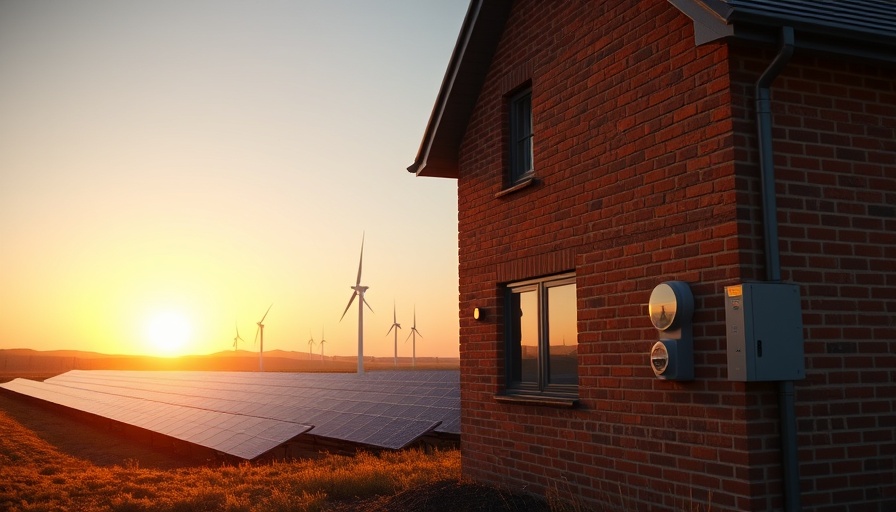
 Add Row
Add Row  Add Element
Add Element of Holistic Wellness Practices
New York's Landmark Rule Mandates All-Electric Buildings: A Game Changer for Climate Action


Will Texas's Solar Power Boom Lower My Electricity Bill?
Update Texas Solar Power Surge: A Game Changer for Utilities In an era defined by the need for sustainable energy solutions, Texas stands at the forefront, experiencing a remarkable increase in solar energy production. As the state officially takes the lead in planned solar capacity, residents are keenly watching their utility bills, wondering if this eco-friendly transformation will translate into savings. While the answer may be more complex than expected, the data suggests promising trends in electricity generation and pricing. How Does Texas Become a Solar Power Leader? Texas's ascent in solar energy isn't merely a blip on the radar; it signifies a fundamental shift in the state's energy framework. Solar now ranks as the third-largest energy source on the Electric Reliability Council of Texas (ERCOT) grid. In the first half of the year alone, solar and wind contributed an impressive 40.2% of ERCOT's electricity, revealing the state's commitment to green energy. Electricity Bills: The Big Question With the influx of solar energy, many Texans are left questioning how this will impact their monthly energy bills. The ERCOT market operates like a dynamic auction, where electricity prices fluctuate based on supply and demand. More solar-generated electricity means lower wholesale prices; however, these discounts may not always trickle down to consumers due to various market dynamics. Future Predictions: Will Savings Reach Your Wallet? Despite the promising figures in solar generation—31 million megawatt-hours produced in the first half of the year, double compared to recent years—residents should remain cautious. The true question is whether decreased wholesale prices will reflect in retail prices. ERCOT's significantly low risk of rolling blackouts, now down to 0.30%, fortifies the case for more reliable energy yet the disconnect between wholesale and retail electricity prices remains a challenge for consumers to navigate. The Broader Impact of Solar Energy The implications of Texas’s solar boom extend beyond just individual bills. Not only has solar drastically reduced the potential for outages, but it contributes to environmental sustainability, continuously pushing Texas to the forefront of renewable energy initiatives. As we look toward a future strongly influenced by clean energy, understanding and adapting to these changes will become increasingly vital. As Texas continues to lead in solar energy, now is the time for residents to actively engage with their local energy policies, advocate for fair pricing, and consider sustainable living practices. With proper awareness and action, Texans can reap the benefits of this solar revolution in ways that align with both their financial and environmental goals.

The Alarming Connection Between Pesticides and Monarch Butterfly Die-Offs
Update The Troubling Decline of Western Monarch Butterflies In a harrowing revelation, a recent study has implicated pesticides as a key factor in the alarming mass die-off of Western monarch butterflies. This event, which transpired in 2024 near the Pacific Grove Monarch Sanctuary in California, has drawn the attention of environmental scientists and conservationists alike. Pesticides Found at Lethal Levels The research team, led by Staci Cibotti at the Xerces Society for Invertebrate Conservation, demonstrated that hundreds of dead monarchs exhibited signs of neurotoxic pesticide poisoning. Through advanced laboratory techniques, including liquid and gas chromatography, they discovered an alarming presence of 15 different chemical substances on the butterflies, predominantly insecticides that are highly toxic to insects. Rather worryingly, each butterfly was found to carry an average of seven different pesticides, with some chemicals reaching lethal concentrations. Understanding the Threat Western monarchs are particularly vulnerable during their overwintering months along the California coastline. Here, they face an increased risk due to pesticide drift from neighboring agricultural and urban settings. Despite extensive investigations by local officials, the source of these harmful chemicals remains elusive, underscoring the urgent need for stricter regulation and monitoring of pesticide use in these sensitive ecosystems. According to Cibotti, "Although a review by Monterey County could not determine the source of the chemicals, the high levels detected suggest that insecticides were likely responsible for the monarch deaths.” The Bigger Picture: A Species in Peril Sadly, this episode is far from isolated. The splendid Western monarch population has plummeted by almost 95% since the 1980s. The International Union for Conservation of Nature has listed migratory monarch butterflies as endangered, and forecasts from the U.S. Fish and Wildlife Service predict a staggering 99% chance of extinction by 2080 if current trends continue. Only 9,119 Western monarchs were recorded in the recent count, depicting a troubling outlook for the species. Why Should We Care? The decline of the Western monarch butterflies is not merely an environmental statistic; it resonates deeply within our collective ecological consciousness. Monarch butterflies play a crucial role in our ecosystems as pollinators, contributing to the health of numerous plants and agricultural systems. Their decline can signal broader issues with biodiversity loss and environmental degradation that impact human populations as well. Actions Needed for Conservation Given the clear connection between pesticides and the decline in monarch populations, concerted measures must be taken to create more environmentally friendly agricultural practices. Public awareness and community action can substantially drive forward the conservation of these charismatic insects. Educational initiatives focusing on sustainable farming, chemical-free gardening, and habitat preservation can help galvanize community efforts. Conclusion: A Call to Action In preserving the delicate balance of our ecosystems, we must heed the lessons presented by the plight of the Western monarch butterfly. Advocate for policies that promote organic farming practices, support local conservation efforts, and demand more stringent regulations on pesticide application. By acting collectively, we can help secure a future for not only monarchs but countless species that share their habitat.

DRC's Oil Auction Threatens Critical Gorilla Habitats and Ecosystems
Update Threat to Biodiversity: The DRC's DilemmaThe Democratic Republic of the Congo (DRC) is celebrated for its stunning biodiversity and expansive forests—home to endangered mountain gorillas and a variety of endemic species. However, the nation's recent move to auction off more than half of its land, including critical habitats for these species, to oil and gas drilling companies marks a troubling chapter in the struggle to balance conservation with economic development.Human Impact and Community VoicesAs per estimates, nearly 39 million Congolese citizens depend on these forests for their livelihoods, including Indigenous communities whose way of life is entwined with the land. Pascal Mirindi, campaign coordinator at Notre Terre Sans Pétrole, emphasizes the inconsistency of these oil policies with the government’s ecological corridor initiatives. His argument highlights a deep concern: "Where is the logic? Where is the coherence?" Such sentiments resonate deeply in a nation where local communities are often the first affected by environmental degradation.The Cuvette Centrale: A Natural Treasure at RiskThe Cuvette Centrale stands as the world's largest tropical peatland complex, vital for carbon storage and biodiversity. The DRC's oil plans threaten this ecological jewel, endangering not only local wildlife but also global climate efforts, as it stores around 30 gigatons of carbon. As such, the newly designated oil blocks overlap with protected and biodiverse areas, threatening the integrity of established climate initiatives, including the Kivu-Kinshasa Green Corridor.Global Repercussions: Climate Change and Ecological IntegrityThis precarious environmental decision does not just affect the DRC. The global ramifications of carbon emissions from oil drilling could be catastrophic. The Cuvette Centrale's degradation can significantly contribute to climate change, increasing global temperatures and affecting weather patterns worldwide. This interconnectedness reminds us that the fate of Congolese forests is tied to global environmental well-being.Social and Economic DilemmasEconomic gains from oil extraction may appear lucrative for the DRC government, but the social cost could be unfathomable. A holistic approach is necessary—one that weighs the immediate profits against long-term ecological and societal health. Conservation stands not only as an environmental necessity but as a moral imperative to protect vulnerable communities and preserve biodiversity.The current situation in the DRC invites us to reflect on how individual actions can align with global conservation efforts. Advocacy and awareness can serve as powerful tools for change. Engaging with organizations that promote environmental stewardship in the DRC can forge stronger ties between local communities and global supporters.ConclusionThe auctioning of DRC's pristine forests for oil drilling presents a complex web of ecological, social, and economic challenges. We must act—advocating for policy changes that align with sustainable development while protecting incredible biodiversity. Our engagement can amplify the voices of those affected and highlight the need for coherence in conservation efforts worldwide.

Write A Comment